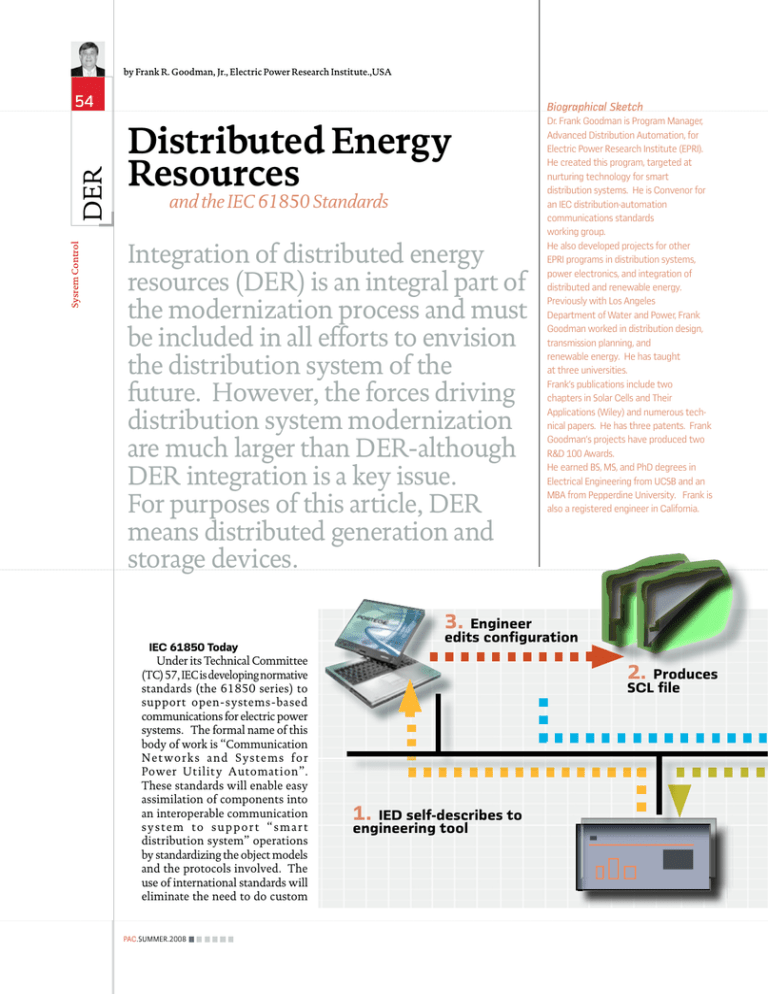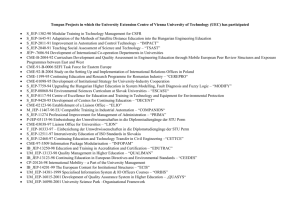Distributed Energy
advertisement

by Frank R. Goodman, Jr., Electric Power Research Institute.,USA Sysrem Control DER 54 Biographical Sketch Distributed Energy Resources and the IEC 61850 Standards Integration of distributed energy resources (DER) is an integral part of the modernization process and must be included in all efforts to envision the distribution system of the future. However, the forces driving distribution system modernization are much larger than DER-although DER integration is a key issue. For purposes of this article, DER means distributed generation and storage devices. IEC 61850 Today Under its Technical Committee (TC) 57, IEC is developing normative standards (the 61850 series) to support open-systems-based communications for electric power systems. The formal name of this body of work is “Communication Net work s and Syst ems for Power Ut ilit y Automat ion”. These standards will enable easy assimilation of components into an interoperable communication system to support “smart distribution system” operations by standardizing the object models and the protocols involved. The use of international standards will eliminate the need to do custom PAC.SUMMER.2008 Dr. Frank Goodman is Program Manager, Advanced Distribution Automation, for Electric Power Research Institute (EPRI). He created this program, targeted at nurturing technology for smart distribution systems. He is Convenor for an IEC distribution-automation communications standards working group. He also developed projects for other EPRI programs in distribution systems, power electronics, and integration of distributed and renewable energy. Previously with Los Angeles Department of Water and Power, Frank Goodman worked in distribution design, transmission planning, and renewable energy. He has taught at three universities. Frank's publications include two chapters in Solar Cells and Their Applications (Wiley) and numerous technical papers. He has three patents. Frank Goodman's projects have produced two R&D 100 Awards. He earned BS, MS, and PhD degrees in Electrical Engineering from UCSB and an MBA from Pepperdine University. Frank is also a registered engineer in California. 3. Engineer edits configuration 2. Produces SCL file 1. IED self-describes to engineering tool 55 engineering of the communication system in every instance and use a “plug and play” process instead. The end result is more cost-effective and rapid development of the communications systems for smart distribution systems, and eventually for entire power systems. The development of standards under TC57 is performed by volunteer working groups (WG). The 61850 series of standards is aimed at the communication needs for real-time operations of smart power systems. It also manages other related standards work, including work on standards for power system business enterprise (WG 14) and standards for information security (WG 15). Overall coordination is the responsibility of WG 19. Object models (information models of equipment) in the 61850 series are broken down into a structure of logical nodes. An object model can be thought of as the building and the logical nodes as its bricks. This approach is by intentional design. The intent is to be able to reuse the logical nodes wherever possible as the modeling of more device types is added to the 61850 series. This approach achieves efficiency in adding new device models and consistency in naming model attributes throughout the entire series. The portion of IEC 61850 for substations has been completed by WG 10 and released. Major vendors are now offering substation equipment that conforms to 61850. Utilities worldwide are increasingly specifying it for substations, and substations providers are installing turnkey 61850 substations. This standard is the lynch pin for an expanding series that will addresses interoperability of the entire power system. Maintenance and updates for the substation standard are being performed by WG 10. Early Benefits of IEC 61850 The benefits of using IEC 61850 were shown for an actual European utility substation case-study example. A primary benefit in the near term is reducing the engineering time necessary to configure the intelligent electronic devices (IEDs). The case study shows that there was an order of magnitude reduction in International communication system standards needed to realize the full value of DERs in future distribution system operations. these engineering time requirements for the case presented. Figure 1 illustrates automated configurat ion enabled by 61850-compliant devices via self-description and automated engineering tools. Each device vendor provides a Substation Configuration Language (SCL) file for use with these tools. The devices can then be configured from office computers. The same type of process could be used to update simulation models from IEDs and servers in the field. New device settings could be sent to the field from the engineer’s computer. In the future, this two-way automation IEC 61850 Part 7-420 contains the normative standard information models for DER devices 1 Office-to-field linkage enabled by IEC 61850 4. Download configuration to Mini-Grid control The use of self-description in automated engineering tools improves significantly the configuration process. 5. Mini-Grid control updates to several IEDs PAC.SUMMER.2008 Sysrem Control DER 56 In many cases the primary value of DER to distribution system operations will come from its use as part of a bag of tools to improve reliability, power quality, and other distribution system support functions—as opposed to merely being an energy source. will enable efficient and accurate DER deployment and integration into active distribution management systems. Increasing the Value of DER in Distribution System Operations Depending on the circumstances, DER can be a contributor to meeting the energy delivery requirements of an electric utility. Usually, the amount of energy that may be available locally from DER can be used locally and it is not exported. In many situations, the incremental cost per kWh of the energy will limit the use of DER to peak periods when lower cost energy is not available from other sources, or to emergency situations in which there is no alternative. The type of DER and local emissions limits may also limit what can be done with it. Diesel-engine generators can be limited to a very small number of hours of run time per year and therefore may only be used for emergency power supply. Renewable-based DER are intermittently available depending on the resource availability and are usually run to capture the resource whenever it is available, which reduces the consumption from fuel-burning alternatives. DER use for emergency power supply may be taken one step beyond meeting the needs of an individual customer’s load by intentional islanding of distribution circuits via active distribution management in which the demand and DER in a given circuit or group of circuits can be aligned with each other, and the circuit or circuits can then be islanded to operate in stand-alone mode during emergencies. This concept is often referred to as a “microgrid”. Another use of DER may be to contribute to integrated volt/ VAR management in distribution operations. The DER can be used for power factor correction in coordination with switched capacitor banks, power electronic VAR compensators and other means. PAC.SUMMER.2008 With proper design, this coordinated operation could improve voltage profiles and reduce electrical losses in distribution circuits. For these system support functions to work when all or some of the DER is not utility owned, the appropriate contractual arrangements will need to be in place and the distribution system protection and control capabilities will need to be aligned with these modes of operation. These distribution-system-support options for use of DER have been extensively studied and discussed over the past 30 years. Literally, thousands of papers and reports have been published on the subject. These system support options are often referred to as “ancillary services”, but in some situations the system support functions may be more important than any kWh value that can be delivered to the distribution system operator. Some believe that system support functions may be the greater role DER plays in distribution operations and will be the primary functions in distribution operations, rather than ancillary functions. However, renewable-based DER would tend to be used more for its kWh value (i.e., run when the renewable resource is available), than may be the case with other DER. To improve the viability and use of DER in these support functions, an easy, cost-effective and seamless communication system for integrating the DER into active distribution system management and control is needed. From that standpoint, DER is one of the active components in a distribution system that must be made interoperable with other active components (switchgear, capacitor banks, etc.). Therefore, IEC 61850 will include DER as part of the body of standards, as discussed next. Communication Systems for DER Figure 2 shows the possibilities for placement of various types of DER in a power distribution system. As the reader may have surmised by now, the communication systems for DER are not something unto themselves, but rather a part of the overall communication infrastructure for distribution system operations. IEC Standard 61850, Part 7-420 has been under development for the past few years and has now reached the point of Final Draft International Standard (FDIS). As such, it is anticipated that it will be released by IEC in the coming year. An exact date is not yet available. Part 7-420 contains the normative standard information models for DER devices and comprises a document of about 100 pages. The information models provide standardized names and structure for the data that is exchanged with the DER devices. This document has been developed by a working group (WG 17) with participation from 12 countries. This document includes the information models for four DER types: Photovoltaic power systems Fuel cell power plants Reciprocating engine generator systems Combined heat and power systems These four specific DER types were chosen for the normative document due to the availability of domain information at the time work was started and due to the prior existence of a standard for wind power. However, some of the logical nodes in the document are generically applicable to all types of DER. The logical nodes in the DER information models are integrated into the schema of the overall 61850 series of standards. For some logical The object models can be applied to all types of DER . 57 CHESF 3 Management concept The overall concept of active distribution management and control DERs can play a valuable role The standard in future distribution system enables operations. interoperability Advanced real-time monitoring systems nodes, it was necessary only to refer to those that already existed in other parts of the series, in keeping with accepted practice for the standards. The logical nodes in this document are intended for use with DER, but may also be applicable to central-station generation installations that are comprised of groupings of multiple units of the of the IEDs with distribution Active Distribution Management Control algorithms management and control, without State estimation tool excessive custom engineering 2 Communication Systems for DER Possibilities for placement of various types of DER in a power distribution system Figure 2: Central Generating Substation DERs can be placed at all levels of the electric power system, as well as at utility customers' sites. Step-Up Transformer Distribution Substation Gas Turbine Microturbine Distribution Substation Receiving Substation Recip. Engine Distribution Substation Commercial Photo voltaics Fuel Cell Recip. Engine Cogeneration Batteries Residential Industrial Commercial PAC.SUMMER.2008 Sysrem Control DER 58 The DER object models can be also used at the local control level. same types of energy conversion systems that are represented by the DER logical nodes in this document. This applicability to central-station gener at ion is st rongest for photovoltaics and fuel cells, due to their modular nature. Active distribution management systems Making power distribution systems smarter will require more sophisticated management and control systems than have been in use in the past. In particular, using more smart devices in a distribution system with require active distribution management and control systems to strategically use the smart devices in a coordinated manner the maximizes the benefits to distribution system operations. In general, active distribution management and control systems include: The distribution monitoring system capabilities to know the active equipment state information, voltage, current, power factor, power quality, and other parameters widely throughout the system. Data processing capabilities to handle large amounts of real-time data coming from the monitoring systems Simulations tools to do state estimation and support control algorithms in determining dispatch actions that are needed. Control systems, including control algorithms to dispatch the active components and achieve the desired distribution management functions in real-time distribution operations. PAC.SUMMER.2008 Figure 3 illustrates the overall concept of active distribution management and control. The IEC 61850 standards are needed to enable interoperability of the IEDs in the distribution system with active distribution management and control, without excessive custom engineering in every case. A key need at this time is pilot application projects to try out new approaches for active distribution management. Such pilots may or may not include DER. To achieve successful active distribution management with DER integration, the DER object models do not need to be installed in the DER devices themselves. It may be easier to install them at the local control level with direct links to the DER devices. This approach may be particularly useful for retrofits to existing DER installations, which are frequently not owned by the distribution utility serving that area. Next steps for IEC 61850 To achieve this vision for active distribution management with fully integrated DER, the IEC 61850 series of standards needs to be completed. WG 17 is being expanded to develop the object models for distribution feeder and network equipment, such as switchgear, capacitor banks, and reclosers. This will involve extensions and adaptations from the substation work and reuse of logical nodes from the substation and DER work wherever possible. WG 17 will also maintain the DER standards and add other DER types (such as storage and electric vehicle charging), as the necessary domain information becomes available. The new standards will make use of existing logical nodes as was done in the past and create new logical nodes only as needed. It is believed that much of the distribution feeder and network equipment can be handled via a technical report that explains how to apply models from the substation work at the feeder and network level. As such, the new work will be closely coordinated with that of WG-10 which maintains the substation standards. As with past work, all future work depends on the volunteer efforts of working group members who contribute their time to obtaining or developing the domain information necessary for modeling the devices. The timeframe for completion of new standards will depend on the availability of the necessary domain information and the willingness and ability of members to participate in the standards writing. Additional active members are welcome to join the working groups via the national committee processes that apply in their countries. Increased support from the stakeholders in the standards writing is needed and will hasten the completion of the standards. Current Standards Adoption Issues IEC61850- confor ming substations are now being sold worldwide by all major substation vendors. There is a need now to plan pilot application projects associated with trial use of the DER standards in a variety of use cases and be ready to implement the trials as soon as the standards are available from IEC. There is also a need to begin trial applications in a variety of use-case situations of object models from the substation standard at the feeder and network level. This will aid the new work on feeder and network standards by helping to understand what parts of the existing 61850 can be reused at the feeder and network level and what gaps exist that may require development of new normative standards. Availability of high-quality domain information is essential for the development and implementation of the models. 59 4 Logical devices and logical nodes for DER systems Recip Engine Fuel Cell Photovoltaic Combined Heat Power DCIP, DFCL, DSTK, DFPM DPVM, DPVA, DPVC, DRTC DCHC, DCHI, DCHX, DCTS DER Unit Controler MFUL, DFLV MMXU ZBAT, ZBTC Energy Converter Battery System Storage Device MFUL, DFLV Exciter Fuel System MFUL, DFLV DGEN, DRAT, DRAZ, DCST Generator Unit MMXU Power System Measurements YRCT, YINV MMDC DC/AC Converter DER Plant Electrical Connection Point (ECP) DCRP, DOPA, DOPR, DOPM, DPST, DCCT, DSCC, CSWI, XCBR, MMXU ECP ECP DER Circuit Breaker M CSWI XCBR MMTR CSWI XCBR CSWI XCBR DER Circuit Breaker Load Circuit Breaker M MMTR PBRO PBTC PTUF PTOF M MMTR DER Protective Relaying Local Loads Electric Power System Physical Measurements MTPM MPRS MHET Temperature Pressure Heat MFLW MVBR MENV Flow Vibration Emission MMET Metereological Energy Converter = Microwives, Fuel Cell, Photovoltaic System, Wind turbines, Diesel Generators, Combustion turbines Storage Device = Battery, Pumped Hydro, Superconducting Magnetic Energy Storage, Flywheels, Microflywheels Converter = DC to AC, frequency conversion, voltage level conversion Auxiliaries = Battery, Fuel Cell PAC.SUMMER.2008




